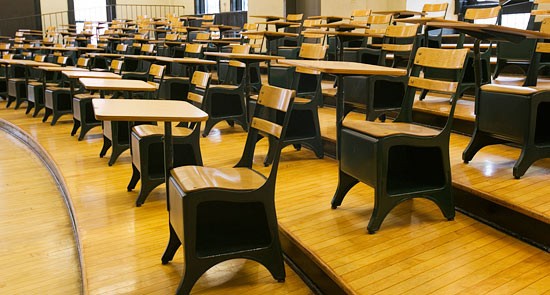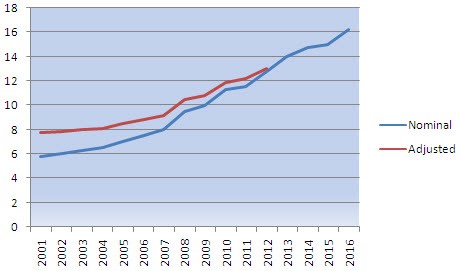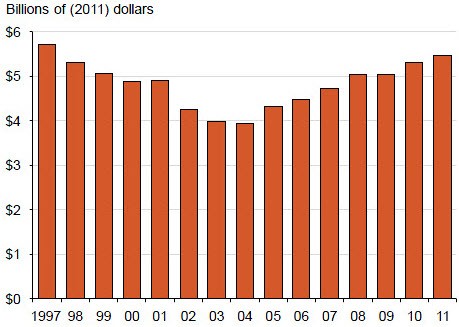
Universities are furious $2.3 billion is to be cut from higher education to help pay for the Gonski reforms on education spending. But given higher education funding is up 50% since 2007, what are they worried about?
That was the message from Prime Minister Julia Gillard on ABC Radio National this morning ahead of negotiations with the states on Friday. Quizzed on the cuts to universities — particularly in light of Australia’s 25th ranking of 29 advanced economies when it comes to public funding of universities — the PM replied:
“What we are asking unis to do is against a backdrop — where there has been growth in university funding by this government of more than 50%, more than half — we are asking universities to accept a lower growth rate.”
Has the current Labor government — with Gillard serving first as education minister and then PM — actually increased the amount of federal funding universities receive by over 50%? Let’s take a look at the numbers …
First, to clarify the cuts. Higher education will by hit by a 2% efficiency dividend next year, followed by 1.25% the next — saving the government about $900 million. Currently students who pay HECS fees up front receive a 10% discount — that discount will be dumped. The Student Start-up Scholarship — a program that provides disadvantaged university students on welfare around $2000 a year for textbooks and other school expenses — will now have to be repaid once a student starts working. Plus, tax concessions for work-related education expenses will now be capped at $2000.
As the social media backlash against the higher ed cuts began, Gillard’s team quickly published this handy graph on her Facebook page:
“Spending on Higher Education will continue to rise — just slightly more slowly,” it claims, showing total higher education funding of about $8 billion in 2007 rising to nearly $17 billion in 2016. The office of Higher Education Minister Craig Emerson confirmed to Crikey the graph only covers teaching and learning direct grants (the Commonwealth Grant Scheme), the student loan system (FEE-HELP or HECS ) and money for university research.
And those figures on the left are nominal — not adjusted for inflation. If they were, they would look a little more like this (note: this graph was made on a best estimate of the figures and reflects 2012 dollars):

So by Crikey‘s calculations, there’s been around a 40% increase in higher education funding since Labor won in 2007. This compares to the Higher Education Minister’s claim of a 56% increase and the prime minister’s “more than 50%” declaration.
A graph from the Grattan Institute breaks down the funding for the Commonwealth Grant Scheme a little more clearly (and provides it in 2011 dollars, rather than a nominal figure):

The Grattan Institute notes:
“The number of student places is therefore a key driver of total spending, in total and on each eligible higher education provider. Before 2012, the Government capped the number of Commonwealth-supported student places. From 2012, the number of bachelor-degree undergraduate Commonwealthsupported places is largely uncapped (section 5.2.1). This is forecast to have a significant effect on total CGS spending. The DIISRTE budget forward estimates predict a 27 per cent increase between 2011-12 and 2015-16, or about $1.5 billion. These increases represent a substantial reversal of government policy. Between 1997 and 2004 operating grant funding (the CGS predecessor) dropped in real terms almost every year, as seen in figure 15.”
Meaning, while higher education funding is up significantly since Labor took control, the figures are still down in real terms on what universities were getting in 1997 when John Howard first took control.
There’s been a number of major higher education policy changes under Labor, including the Bradley Review in 2008 that resulted in an additional $5.4 billion to support higher education and research over four years. The government also recently responded to the Higher Education Base Funding Review, noting that from 2012-2015 the Gillard government will invest $58.9 billion in higher education and rejecting the review’s recommendations for an increase to the base funding level per university place.
So we’re calling claims of a significant increase mostly true — depending on how you read some rubbery figures.









Thanks Amber and Kyla for this worthy critique
Ms Gillard PM’s government should be congratulated for their response to the Gonski report.
The re focussing of resources to the development of children at the earliest opportunity is to be commended.
Many studies, over many years, have established that the earlier we set about developing, exciting and exploring the inquisitive and enquiry mind together with establishment of the fundamental skills to aid in critical analysis, results in a more intelligent and socially balance adult.
Academics and University Administrators will naturally bleat about the redirection of some of their funds, but it should be remembered that it is these same people who rationalised their own decreasing standards by lamenting about the standards of the school graduates.
It could be suggested that Universities, Industry Leaders, Bureaucrats and Politicians should take the time, while awaiting the arrival of these better prepared youth, to reflect on the hollowing out of philosophy and pure science departments and genuine research institutes.
Through the influence of industry lobbyist’s, universities and many of our research institutes have focused more and more of their resources on applied science, to the detriment of their exoteric academic pursuits. Many of the doctoral papers I have read over the past ten years or more can be characterised as explorations of an up to date thesaurus, they’re nothing more than vague regurgitations of ideas expressed in modern jargon and do little to add or enhance the institutes store of intellectual value. We get a constant diet of it from both our universities and ‘think tanks’ daily.
Meanwhile, Crean’s Art Policy document recognises the importance of an early exposure to the arts and culture development, is reinforced by studies that show the early introduction to these experiences, helps to release the natural creative expression embodied in all our children.
The nation’s future will be in these people’s hands pretty soon and they deserve our focus on the quality, breadth and depth of the early their early holistic development.
I see a rare instance of coherence in both these policies and commend them both.
Everyone complaining about this should look carefully at the third graph and the way funding dropped during the Coalitions term and has risen steadily again under Labor. You may not like the cuts, but at least the $$$ are staying within education, try and imagine what Abbott and his pals would do!
Go Gonski!
What was interesting was the Coalition’s reaction to the cut. The usual “we’ll oppose it in opposition and reverse it in Government” was gone to be replaced by “we can’t protect the sector”. The austerity measures have simply come early. Joe Hockey must be pleased.
I choked on Abbott’s salty bawls over “the iniquity of it” – after those “H.C.* Nelson” cuts.
[(*Howard & Costello)]
It would have been interesting to see a comaprative split between rises in student contributions (HELP etc) and Commonwealth grants.